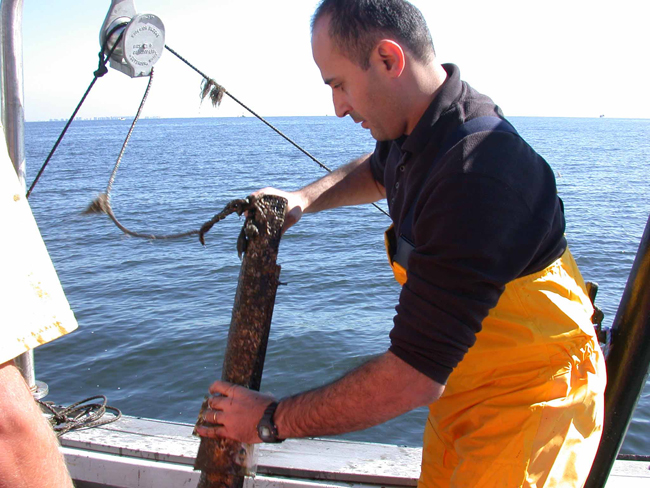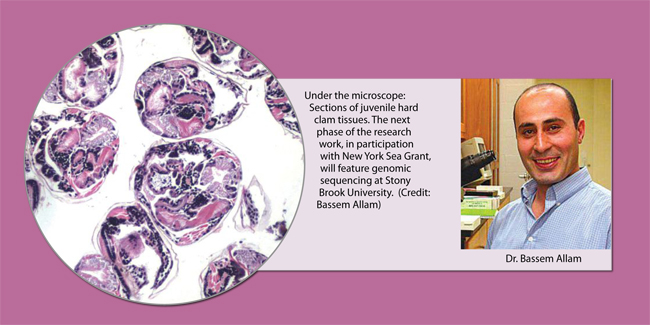
Dr. Bassem Allam pulling up a cage of juvenile clams. His new research involves collaborators in five Atlantic states in the US, as well as contributions from Canada, France, and the UK. Credit: Bassem Allam.
— By Lynn Fantom; Published in Hatchery International - May / June 2020
Stony Brook, NY, June 1, 2020 - A consortium of scientists is on the brink of completing a genomic map of the hard clam, Mercenaria mercenaria, in an ongoing offensive against QPX disease and the effects of extreme heat.
“It is 97 percent drafted,” says lead researcher Dr. Bassem Allam of Stony Brook University in New York.
Allam follows years of studies on how to reverse the shrinking clam populations along the Eastern Seaboard. He says this latest collaboration among five states and international stakeholders promises to finally yield “superior clam stocks.”
While oyster farming has been thriving, harvests of hard clams have faltered. According to the Aquaculture Census of the U.S. Department of Agriculture (USDA), the number of hard clams sold declined more than 10 percent between 2005 and 2018, while that of Eastern oysters shot up almost 60 percent.
“It’s really a contrast,” says Allam, attributing the decline to market constraints and natural mortality, like predation and disease.
Parasite Unknown
Still, clams rank second among the most valuable species in U.S. aquaculture, according to the National Oceanic and Atmospheric Administration (NOAA). Hard clams in particular, which are also known as quahogs, are extensively cultured along the Atlantic coast. They are the most important marine resource in several states, including New York, Virginia and Florida.
But over the years, growers have suffered setbacks during disease outbreaks and heat waves.
For example, QPX (“quahog parasite unknown”) disease was first observed in Canada in 1959 and has since ravaged farms in Massachusetts, Virginia, New Jersey, New York, Nova Scotia and Prince Edward Island. Marked by chipped shell edges, the disease causes swelling and discoloration of the clam’s body wall and, in fact, can be fatal to the bivalve.
With such significant economic consequences, defeating QPX has been a high priority for aquaculture researchers. The good news, Allam says, is that the threats of both a harsh environment and QPX disease can be offset by selective breeding.

Researching Resistance
In a study funded by the USDA in 2016, Allam and his colleagues compared whether genetically distinct clam stocks resisted QPX disease. They were successful at identifying heritable traits associated with disease resistance in what Allam calls “a draft genome.”
They then selectively bred lines in New York during the summer of 2018 and deployed them in Massachusetts and New Jersey a year later to study the performance of these markers “at the same time, same place.”
The new research, funded by NOAA in 2019 under the National Aquaculture Initiative, will take advantage of single nucleotide polymorphism (SNPs).
“One single change in the DNA sequence is very important because it’s going to lead, ultimately, to different functional traits — to whether a hard clam is disease resistant or susceptible,” says Allam. “So, there is real hope down the line.”
The project, led by Allam in participation with New York Sea Grant, brings together scientists from five Atlantic coast states from Florida to Massachusetts, as well as contributions from Sorbonne Université in France.
Clams for the study have been coming in from Florida to Prince Edward Island, and as far away as the U.K.
In the upcoming months, the team will complete the sequencing and assembly of the hard clam genome. From there, they will develop a genotyping platform or SNP array that can identify novel genetic markers associated with key traits.
The next step will be a validation period to audit resistance to QPX disease and heat stress.
These activities should take researchers well into 2022, but in the end, the platform will allow growers of hard clams to select traits relevant to various regions, including adaptability to salinity levels and tolerance of ocean acidification.
Video from "Stopping the Disease that has Wracked the New York Hard Clam Fishery" (December 2018)
More Info: New York Sea Grant
New York Sea Grant (NYSG), a cooperative program of Cornell University
and the State University of New York (SUNY), is one of 34 university-based
programs under the National Oceanic and Atmospheric Administration’s
National Sea Grant College Program.
Since 1971, NYSG has represented a statewide network of integrated
research, education and extension services promoting coastal community
economic vitality, environmental sustainability and citizen awareness
and understanding about the State’s marine and Great Lakes resources.
Through NYSG’s efforts, the combined talents of university scientists
and extension specialists help develop and transfer science-based
information to many coastal user groups—businesses and industries,
federal, state and local government decision-makers and agency managers,
educators, the media and the interested public.
The program maintains Great Lakes offices at Cornell University, SUNY
Buffalo, SUNY Oswego and the Wayne County Cooperative Extension office
in Newark. In the State's marine waters, NYSG has offices at Stony Brook
University in Long Island, Brooklyn College and Cornell Cooperative
Extension in NYC and Kingston in the Hudson Valley.
For updates on Sea Grant activities: www.nyseagrant.org has RSS, Facebook, Twitter, and YouTube links. NYSG offers a free e-list sign up via www.nyseagrant.org/nycoastlines for its flagship publication, NY Coastlines/Currents, which is published quarterly. Our program also produces an occasional e-newsletter,"NOAA Sea Grant's Social Media Review," via its blog, www.nyseagrant.org/blog.